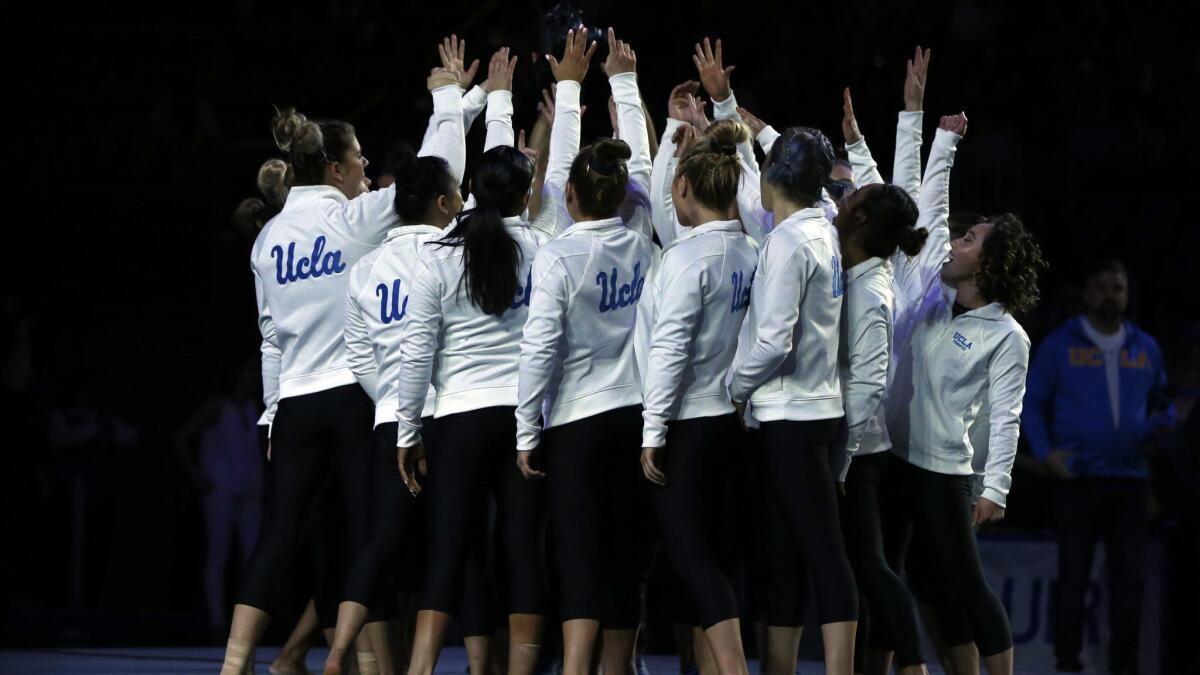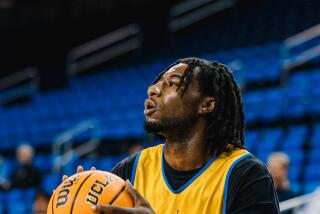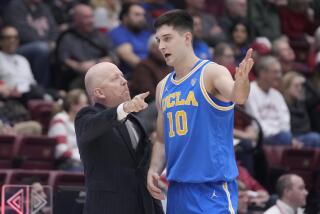Column: UCLA gymnastics is a surging powerhouse with a following to match

Katelyn Ohashi was on the floor and Pauley Pavilion was rocking.
The audience watching Ohashi perform her signature routine was larger than the typical UCLA men’s basketball crowd, younger and more energetic than a football crowd.
When Ohashi clapped her hands over her head, spectators clapped along with her. When she stuck a landing, the estimated 4,000 students seated near the stage whooped. When she raised her arms to signal the end of another perfect-10 performance, the 10,000-plus fans in the arena stood and screamed.
This is the new normal for the second-ranked UCLA gymnastics team, which has played in front of growing audiences both at home and on the road. The Bruins drew more than 10,000 fans to each of their last two home meets, including 10,323 fans in a victory over Arizona last week. They sold out a meet at Stanford.
Gymnastics has become a major sport at UCLA, becoming a source of pride for an athletic powerhouse experiencing a series of disappointing seasons in men’s basketball and football.
“It’s a magical season,” coach Valorie Kondos Field said. “Everything’s falling into place.”
The Bruins compete at No. 4 Utah on Saturday and No. 1 Oklahoma next week. They will close the season with home meets against Stanford on March 10 and Utah State on March 16. The showdown with Utah State will mark the final home meet for Kondos Field, who will retire at the end of the season after 28 years as the team’s head coach.
The simplest explanation for the team’s surge in popularity: a viral video of Ohashi’s now-famous floor routine. That’s part of the story, but not the entire story. This was something years in the making. The team drew an average of almost 8,000 fans at home meets last year. What Ohashi did was vault the Bruins into the next level.
“It’s been pretty insane, the amount of people it’s made an impact on,” Ohashi said. “It’s been amazing and such a blessing to be able to bring this much attention to college gymnastics.”
Kondos Field said s home attendance was in the range of 4,000-5,000 for several years. The coach traced back the increase in crowd sizes to Danusia Francis, an alternate on Great Britain’s 2012 Olympic team who competed at UCLA from 2013-2016.
“She was so exotic and she did a beam dismount that nobody in the world has ever done,” Kondos Field said.
The program made concerted efforts to highlight performances such as Francis’ across various social media platforms. In fact, the first UCLA floor routine to produce a viral video wasn’t that of Ohashi; it was Sophina DeJesus’ from 2016.
UCLA’s gymnastics team became one of the most-followed NCAA women’s sports teams on Twitter, Facebook and Instagram. The program’s sizable social media presence positioned the Bruins to take advantage of Ohashi’s floor routine.
Ohashi’s program was designed with the internet in mind. Ohashi also had a floor routine last year that was widely viewed online. To come up with a routine that could reach an even larger audience, Ohashi brainstormed with coaches and support staffers for more than two hours.
“It had to be relatable music, relatable dance and it had to be really joyful,” Kondos Field said.
In reference to the USA Gymnastics sexual abuse scandal that counted current Bruins Kyla Ross and Madison Kocian as victims, Kondos Field added, “Our sport is experiencing a lot of darkness and we wanted to bring a lot of joy.”
Ohashi performed the routine and scored a perfect 10 at a multiteam meet in Anaheim on Jan. 12. The Bruins’ video of it spread everywhere, as it was shared by everyone from Kamala Harris to Janet Jackson.
The crowds followed.
“I don’t know why people wouldn’t watch,” Ross said. “I’m biased, but it’s one of the hardest sports.”
And also fun.
The atmosphere in elite gymnastics is sterile and tense; college gymnastics is more festive.
“I know when I talk to people, they’re like, ‘I watch elite gymnastics on TV, it’s very quiet, it’s not a very interactive crowd,’” Ross said. “I’m like, ‘No, no, no, you have to come to a college meet because it’s very different, it’s very interactive.’ ”
The atmosphere is an important element.
“For three decades now, women’s gymnastics is the premier sport at the Summer Olympics and then the ball gets dropped,” Kondos Field said. “What’s been frustrating in building this program is that we’ve had so many elite and Olympic athletes. You get to see the best in the world right here in Pauley Pavilion. We haven’t told that story well enough to build a massive following sooner.”
UCLA is telling that story by interjecting fun into their routines and spreading the word on social media. The strategy has resulted in more exposure for Olympic gold medalists like Ross and Kocian as well as Ohashi and several others on the team with international experience.
Sign up for our daily sports newsletter »
“All sport is entertainment,” Kondos Field said. “We’re vying for the entertainment dollar. So we’ve got to produce a really tight, seamless, great show.
“As a head coach, your job is more than coaching and recruiting. You need to brand. You need to market. That’s your job as a head coach and I think a lot of head coaches don’t feel that’s their responsibility.”
Ohashi now finds herself the main attraction of every meet in which she competes, with crowds expecting her to score a maximum 10 points. But she doesn’t feel burdened by the expectations.
“I can’t control what the judges give me,” Ohashi said. “I can’t control what other people think. All I can do is go out there and do my best. Mistakes obviously happen. I just try going with the same mind-set every single time, which is to have as much fun as possible.”
Spectators should feel that joy. Many already have, in greater and greater numbers.
Follow Dylan Hernandez on Twitter @dylanohernandez
More to Read
Go beyond the scoreboard
Get the latest on L.A.'s teams in the daily Sports Report newsletter.
You may occasionally receive promotional content from the Los Angeles Times.











